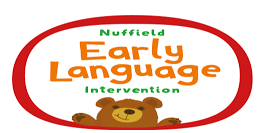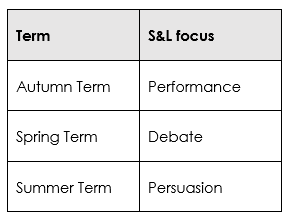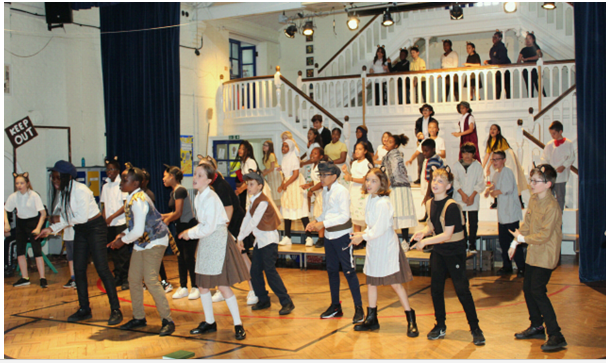English
Our vision: Learning together we will all be exceptional readers and writers, confident speakers and thoughtful listeners!
Reading
Phonics (reading and spelling)
At Sunnyhill, we believe that all our children will become fluent readers and writers. This is why we teach reading through Little Wandle Letters and Sounds Revised, which is a systematic and synthetic phonics programme. We start teaching phonics in Nursery/Reception and follow the Little Wandle Letters and Sounds Revised progression, which ensures children build on their growing knowledge of the alphabetic code, mastering phonics to read and spell as they move through school.
As a result of this programme, all of our children are able to tackle any unfamiliar words as they read. At Sunnyhill, we also model the application of the alphabetic code through phonics in shared reading and writing, both inside and outside of the phonics lesson and across the curriculum. We have a strong focus on language development for our children because we know that speaking and listening are crucial skills for reading and writing in all subjects.
Comprehension
At Sunnyhill, we value reading as a crucial life skill. By the time children leave us, they read fluently, confidently, for meaning and regularly enjoy reading for pleasure. We equip our readers with the tools to tackle unfamiliar vocabulary.
We encourage our children to see themselves as readers for both pleasure and purpose.
Because we believe teaching every child to read is so important, we have Reading Leaders who drive the early reading programme in our school.
How Phonics is taught at Sunnyhill:
In the Nursery we:
-
provide a balance of child-led and adult-led experiences for all children that meet the curriculum expectations for ‘Communication and language’ and ‘Literacy’. These include:
-
sharing high-quality stories and poems
-
learning a range of nursery rhymes and action rhymes
-
activities that develop focused listening and attention, including oral blending
-
attention to high-quality language.
-
-
ensure Nursery children are well prepared to begin learning grapheme-phoneme correspondences (GPCs) and blending in Reception.
In Reception, Year 1 and Year 2 we:
-
teach phonics for 30 minutes a day. We build from 10-minute lessons, with additional daily oral blending games, to the full-length lesson as quickly as possible. Each Friday, we review the week’s teaching to help children become fluent readers.
-
follow the Little Wandle Letters and Sounds Revised expectations of progress:
-
Children in Reception are taught to read and spell words using Phase 2 and 3 GPCs, and words with adjacent consonants (Phase 4) with fluency and accuracy.
-
Children in Year 1 review Phases 3 and 4 and are taught to read and spell words using Phase 5 GPCs with fluency and accuracy.
-
Daily Keep-up lessons ensure every child learns to read
-
Any child who needs additional practice has daily Keep-up support, taught by a fully trained adult. Keep-up lessons match the structure of class teaching, and use the same procedures, resources and mantras, but in smaller steps with more repetition, so that every child secures their learning.
-
We timetable daily phonics lessons for any child in Year 2 and above who is not fully fluent at reading or has not passed the Phonics screening check. These children urgently need to catch up, so the gap between themselves and their peers does not widen. We use the Rapid Catch-up assessments to identify the gaps in their phonic knowledge and teach to these using the Rapid Catch-up resources – at pace.
-
These short, sharp lessons last 15-20 minutes daily and have been designed to ensure children quickly catch up to age-related expectations in reading.
Teaching reading: Reading practice sessions three times a week
-
We teach children to read through reading practice sessions three times a week. These:
-
are taught by a fully trained adult to small groups of approximately six children
-
use books matched to the children’s secure phonic knowledge using the Little Wandle Letters and Sounds Revised assessments and book matching grids on pages 11–20 of ‘Application of phonics to reading’.
-
are monitored by the class teacher, who rotates and works with each group on a regular basis.
-
-
Each reading practice session has a clear focus, so that the demands of the session do not overload the children’s working memory. The reading practice sessions have been designed to focus on three key reading skills:
-
decoding
-
prosody: teaching children to read with understanding and expression
-
comprehension: teaching children to understand the text.
-
-
In Reception these sessions start in Week 4. Children who are not yet decoding have daily additional blending practice in small groups, so that they quickly learn to blend and can begin to read books.
-
In Years 2 and 3, we continue to teach reading in this way for any children who still need to practise reading with decodable books.
-
Once children have reached the thresholds to complete the phonics programme, they follow the Key Stage 2 Comprehension curriculum.
-
Writing and vocabulary are taught through high quality texts during English lessons.
Home reading
-
A decodable reading practice book - in line with the child’s current assessments - is taken home to ensure success is shared with the family.
-
'Reading for pleasure’ books also go home for parents to share and read to children. We share the research behind the importance and impact of sharing quality children’s books with parents through workshops, leaflets and the Everybody read! resources.
-
We use the Little Wandle Letters and Sounds Revised parents’ resources to engage our families and share information about phonics, the benefits of sharing books, how children learn to blend and other aspects of our provision, both online and through workshops.
Additional reading support for vulnerable children
-
Children in Reception and Year 1 who are receiving additional phonics Keep-up sessions read their reading practice book to an adult daily.
Ensuring consistency and pace of progress of phonics
-
Every teacher in our school has been trained to teach reading, so we have the same expectations of progress. We all use the same language, routines and resources to teach children to read so that we lower children’s cognitive load.
-
Weekly content grids map each element of new learning to each day, week and term for the duration of the programme.
-
Lesson templates, Prompt cards and ‘How to’ videos ensure teachers all have a consistent approach and structure for each lesson.
-
The Reading Leader and SLT use the Audit and Prompt cards to regularly monitor and observe teaching; they use the summative data to identify children who need additional support and gaps in learning.
Impact
Assessment
Assessment is used to monitor progress and to identify any child needing additional support as soon as they need it.
-
Assessment for learning is used:
-
daily within class to identify children needing Keep-up support
-
weekly in the Review lesson to assess gaps, address these immediately and secure fluency of GPCs, words and spellings.
-
-
Summative assessment for Reception and Year 1 is used:
-
every six weeks to assess progress, to identify gaps in learning that need to be addressed, to identify any children needing additional support and to plan the Keep-up support that they need.
-
by SLT and scrutinised through the Little Wandle Letters and Sounds Revised assessment tracker, to narrow attainment gaps between different groups of children and so that any additional support for teachers can be put into place.
-
- Fluency assessments measure children’s accuracy and reading speed in short one-minute assessments. They are used:
-
in Year 1, when children are reading the Phase 5 set 3, 4 and 5 books
-
with children following the Rapid Catch-up programme in Years 2 to 6, when they are reading the Phase 5 set 3, 4 and 5 books
-
to assess when children are ready to exit their programme. For Year 1 children, this is when they read the final fluency assessment at 60–70+ words per minute. Older children can exit the Rapid Catch-up programme when they read the final fluency assessment at 90+ words per minute. At these levels, children should have sufficient fluency to tackle any book at age-related expectations. After exiting their programme, children do not need to read any more fully decodable books.
-
A placement assessment is used:
-
The Rapid Catch-up assessment is used
-
with any child new to the school in Year 2 and above to quickly identify any gaps in their phonic knowledge and plan and provide appropriate extra teaching.
-
Statutory assessment
-
Children in Year 1 sit the Phonics screening check. Any child not passing the check
re-sits it in Year 2.
Ongoing assessment for Rapid Catch-up in Years 2 to 6
-
Children in Year 2 to 6 are assessed through:
-
the Rapid Catch-up initial assessment to quickly identify any gaps in their phonic knowledge and plan appropriate teaching
-
the Rapid Catch-up summative assessments to assess progress and inform teaching
-
the Rapid Catch-up fluency assessments when children are reading the Phase 5 set 3, 4 and 5 books for age 7+.
-
-
The fluency assessments measure children’s accuracy and reading speed in short
one-minute assessments. They also assess when children are ready to exit the Rapid Catch-up programme, which is when they read the final fluency assessment at 90+ words per minute.
In year 3, 4, 5 and 6 we:
Teaching reading: Reading practice sessions five times a week
-
Teach children to read fluently
-
Daily teaching of core comprehension skills that underpin the reading domains set out by the National Curriculum
-
Each comprehension skill is modelled and children develop their understanding of each skill individually giving the chance to practise and master.
-
The following comprehension skills are taught:
-
-
Use background knowledge
-
Ask questions
-
Identify the author’s purpose
-
Identify the main idea
-
Sequence
-
Cause and effect
-
Make inferences
-
Predict
-
Summarise
-
Fact and opinion
-
Find facts and details
-
Compare and contrast
-
Make connections
-
Visualise
-
Re-read for clarity
-
Adjust pace - skim and scan
-
Expose children to a range of authors, genres and text types which grow in difficulty via the complexity and length of the texts
-
Ensure reading is promoted across all areas of the curriculum
Home reading
- All children have access to thousands of books through MyOn and Accelerated reader. MyOn is an online library and the children take tests on Accelerated Reader which allows teachers to track progress and ensure pupils are progressing in reading through appropriate books.
-
All children take home a reading for pleasure book which they are encouraged to share with their families.
Additional reading support for vulnerable children
Children are supported through a range of interventions including:
-
Pre-reading
-
The Rapid Catch-up programme (Little Wandle)
-
1:1 reading with an adult
-
Accelerated Reader and MyOn
-
Reading fluency practice
Impact
Assessment
-
Assessment for learning is used:
-
daily within class to identify children who require additional support or those who are working at greater depth within the expected standard.
-
To plan the reading domains and skills which need further exploration and practice
-
-
Summative assessment for Year 3 - 6:
-
Fluency assessments are completed with every child to measure children’s accuracy and reading speed to identify those who need more support with reading fluently.
-
Each term children complete a reading assessment through PiXL.
-
The reading leads scrutinise the data provided to narrow attainment gaps between different groups of children and so that any additional support for teachers can be put into place.
-
The Rapid Catch-up assessment is used
-
with any child new to the school in Year 2 and above to quickly identify any gaps in their phonic knowledge and plan and provide appropriate extra teaching.
Statutory assessment:
-
At the end of Key Stage 2 in year 6, children will take statutory assessments in reading.
Reading support for parents/carers:
-
Regular workshops in phonics and reading are provided to enable parents/carers to support children at home
-
Reading Cafes in EYFS
-
Book fairs
-
Book trolleys so that parents have access to high quality books to take home with their children
-
Accelerated Reader and MyOn
Reading for pleasure across the school
'Reading for pleasure is the single most important indicator of a child’s success.’ (OECD 2002)
'The will influences the skill and vice versa.’ (OECD 2010)
We value reading for pleasure highly and work hard as a school to grow our Reading for Pleasure pedagogy.
- We read to children every day. We choose these books carefully as we want children to experience a wide range of books, including books that reflect the children at Sunnyhill and our local community as well as books that open windows into other worlds and cultures.
-
Every classroom has a book corner that encourages a love for reading. We curate these books and talk about them to entice children to read a wide range of books.
-
In Nursery/Reception, children have access to the reading corner every day in their free flow time and the books are continually refreshed.
-
Children from Nursery/Reception onwards have a home reading record. The parent/carer records comments to share with the adults in school and the adults will write in this on a regular basis to ensure communication between home and school.
-
As the children progress through the school, they are encouraged to write their own comments.
-
The school library is made available for classes to use during the school day. Children across the school have regular opportunities to engage with a wide range of Reading for Pleasure events (book fairs, author visits and workshops, national events etc).
Writing
At Sunnyhill, we recognise and place great value on literacy skills as an essential tool for achievement in all areas of the curriculum, as well as in later life.
We want Sunnyhill pupils to:
-
write clearly, accurately and coherently, adapting their language and style for a range of contexts, purposes and audiences
-
understand and use a wide range of vocabulary
-
apply spelling patterns and rules they learn
-
see themselves as real writers
-
see writing as an interesting and enjoyable process
-
edit their work effectively during and after the writing process.
-
take pride in the presentation of their work
How writing is taught at Sunnyhill:
We use the ‘Literacy Tree’ scheme of work to place high quality children’s literature at the core of teaching and learning. Texts that are chosen engage pupils in the learning of writing and also support their love of reading. From these texts, teachers plan opportunities for different writing compositions.
Teachers also plan writing opportunities linked to termly history, geography, science or RE topics. We ensure that there is a meaningful outcome for a variety of genres so that children are given a real purpose for their writing. Teachers use texts linked to topics and stimulating first hand experiences to inspire writing.
We recognise the importance of writing as a process. Children have regular opportunities to gradually draft and develop their final pieces of writing. Children are given time to edit and improve their written work after feedback from their teacher. The teaching of grammar is interwoven into daily reading and writing lessons so that children are given the opportunity to learn grammar in context.
Handwriting
Handwriting is a basic skill that influences the quality of work throughout the curriculum. By the end of Key Stage 2 all pupils should have the ability to produce fluent, legible and, eventually, speedy joined-up handwriting, and to understand the different forms of handwriting used for different purposes.
Our intention is to make handwriting an automatic process that does not interfere with creative and mental thinking.
Year 1 to Year 6 class teachers follow the ‘Letter-join’ scheme of work to deliver handwriting lessons each week. In Year 1, the children are taught how to write capital letters, numbers and symbols alongside cursive handwriting. Children practice their fine and gross motor skills, they learn how to sit correctly for handwriting using the tripod grip and they are introduced to the different letter families. By the end of Year 6 the children will develop more of a personal handwriting style as they write with automaticity and will learn to write at different speeds with attention to neatness.
Speaking and Listening
How speaking and listening skills are developed at Sunnyhill:
At Sunnyhill, we aim to embed speaking and listening skills across all areas of the curriculum. We encourage pupils to use speaking and listening to solve problems, share ideas and make decisions. We want Sunnyhill children to be able to express their thoughts, rationalise their ideas and talk about their feelings and viewpoints using appropriate vocabulary.
In EYFS, support staff have been trained to deliver the Nuffield Early Language Intervention (NELI). This project is designed to improve the spoken language ability of Reception children.
At Sunnyhill, we know that a good understanding of a wide range of vocabulary supports success across the whole national curriculum. We have identified ‘core’ words that the children will meet in different subjects and in different topics. These words will be revisited and taught in different contexts so that the children develop a deep understanding of their meaning and they become tools with which children can access the knowledge, skills and understanding the curriculum demands. This vocabulary will form a backbone through our curriculum to help to scaffold and develop the children’s learning.
From EYFS to Year 6, children are encouraged to answer questions in complete sentences. In class, all children are allocated talk partners in order to encourage them to speak to one another and share ideas.
Speaking and Listening underpins the reading and writing curriculum at Sunnyhill. Through a range of activities, including drama, discussion and debate and the memorisation and recital of poetry, children are equipped to be confident and eloquent speakers and thoughtful listeners.
Each term we have a whole school speaking and listening focus:
Performance
In the Autumn term, all children have the opportunity to perform in front of their parents in our end of year shows (EYFS Winter Show and Shakespeare Festival). Throughout the year, the children also perform in termly class assemblies. By giving them multiple opportunities to perform on the stage throughout their time at Sunnyhill, the children have an opportunity to showcase their talents and develop their confidence with public performance. In Year 6, the children showcase all of their performance skills in our end of year production.
Persuasion
In the Spring Term, the children consider the use of persuasive language by taking part in class activities where they have to persuade someone to choose a product that they have designed in D&T eg. The children in Year 6 have to design a wind powered car linked to their sustainable development goal of Climate Change.
Debate
In the Summer Term our speaking and listening focus is debate.
In 2020, Year 5 children from Sunnyhill took part in the Lambeth heats of a debating competition facilitated by ‘The Noisy Classroom’ organisation. We were really excited to beat strong competition from other local primary schools to win the competition.







